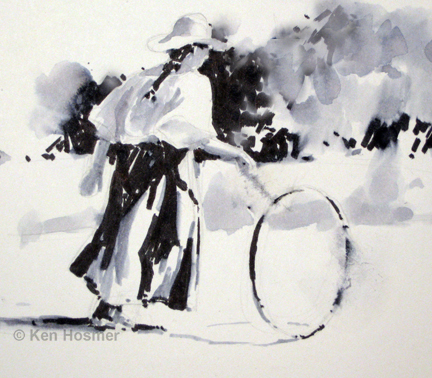
. . . with the simple Ink Sketch.
This fascinating ink wash method started over 20 years ago as a simple teaching tool. Today it has evolved into a mainstay for developing painting ideas.
Featured ink sketch:
'Hoop and Stick'—by Ken Hosmer
My beloved mentor, artist Carl Cogar, was a purist. Photos were not allowed for copying or as reference in his classroom. So with pencil and sketchpad, I recorded my world—I learned to draw. On the closet shelf, I still have a large stack of dog-eared pads with time-smeared pencil sketches.
Years later, as I began teaching painting workshops, I found student drawing skills were very limited; many were copying photographs with little or no editing. Also, I would hear comments such as, "I will learn to draw later. Right now I just want to paint."
Drawing is good for you—like broccoli. So I included one day of drawing with every painting workshop. Today, I use this to teach design, and show students how to properly interpret and revise photographic references.
My favorite method is the ink-wash sketch. All you need is a water soluble black marker (Tombow N15), ordinary #2 school pencil, bristol paper, and a pointed watercolor brush. After a quick pencil outline, you draw in all the darks with the marker, then slide through the ink with a moist brush creating the mid-values. The technique is quite simple and is a great learning tool.
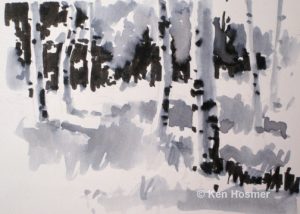
So what can you learn from the ink sketch?
Develop painting ideas. Most painting ideas don't pop into the mind fully developed, rather ideas evolve and grow. Sketching provides a way to experiment and try things before jumping into the painting. In watercolor, it can be very intimidating to make a big change mid painting. It is good to have a general plan, as many a painting has been ruined while trying to fix a problem area. With the ink sketch, I develop a value plan, showing me where to place the darks and most importantly where to save the lights as white paper. In watercolor it is easy to accidentally paint over the lights, and no lights means no sparkle; the painting can go dull in a hurry.
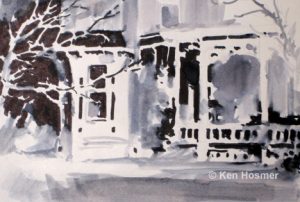
Learn to avoid copying photos. When working from photos, ink sketching builds the 'what if' habit. What if I move this tree? What if I make this area darker or leave that area lighter? We take more chances with a sketch than in a painting. I usually do a preliminary ink sketch from a photograph, making many changes. I then paint from the this as my primary reference. Because the ink sketch provides a simplified map of darks, lights and mid-value areas, it is easier to work from than the photo, and encourages me to play with color variations as I paint.
In this day and age, most artists use photographic references for their art work. It is easy to pause and take a quick cell phone photo. Seldom do we stop long enough to draw or paint. However, I do enjoy plein-air painting, and the ink sketch is a lightweight alternative. It works great outdoors with almost no gear required.
Improve design. Good design is complex to explain. It is helpful to devise simple mental tools to help us visualize a good arrangement of shapes. One of my favorite devices is a 'dark pathway' or 'light pathway'. A pathway is simply an arrangement of dark or light shapes in a connected pattern so that the eye follows the 'path' rather than randomly jumping around the painting. This organizes the painting. The ink sketch is a great way to build pathways. As I ink, I simply add one dark shape, then the next, moving from dark shape to dark shape. At this stage it is easy to see the flowing rhythm of shapes. (See examples.)
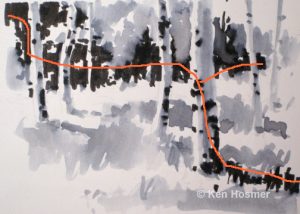 Dark Pathway
Dark Pathway
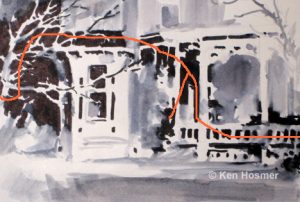 Dark Pathway
Dark Pathway
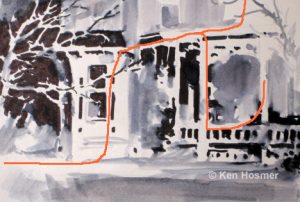 Light Pathway
Light Pathway
Simplify. By its nature, the ink sketch reduces a complicated image into fewer simplified value shapes. This is the foundation for the painting. I have found that if I paint from an ink sketch reference, my painting tends to become more simplified.
Train your brain. You may have noticed that the ink pen doesn't erase. Although this is very intimidating at first, not being able to erase is a good thing—really! One of the mental skills desirable for painting is to make decisions quickly and with conviction. With practice, ink sketching makes us more sure in our decision making—because we can't erase. I also tell my students, "If you make a mistake, ignore it and move on. In the end it is seldom noticeable." In other words, avoid fixing something that doesn't need fixing.
Bottom line: Ink sketching is relatively quick and easy. With practice, it will profoundly improve your painting skills.
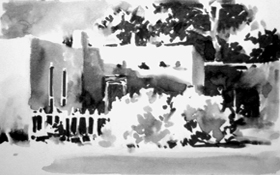
From video - Hosmer's Famous Ink Sketch
